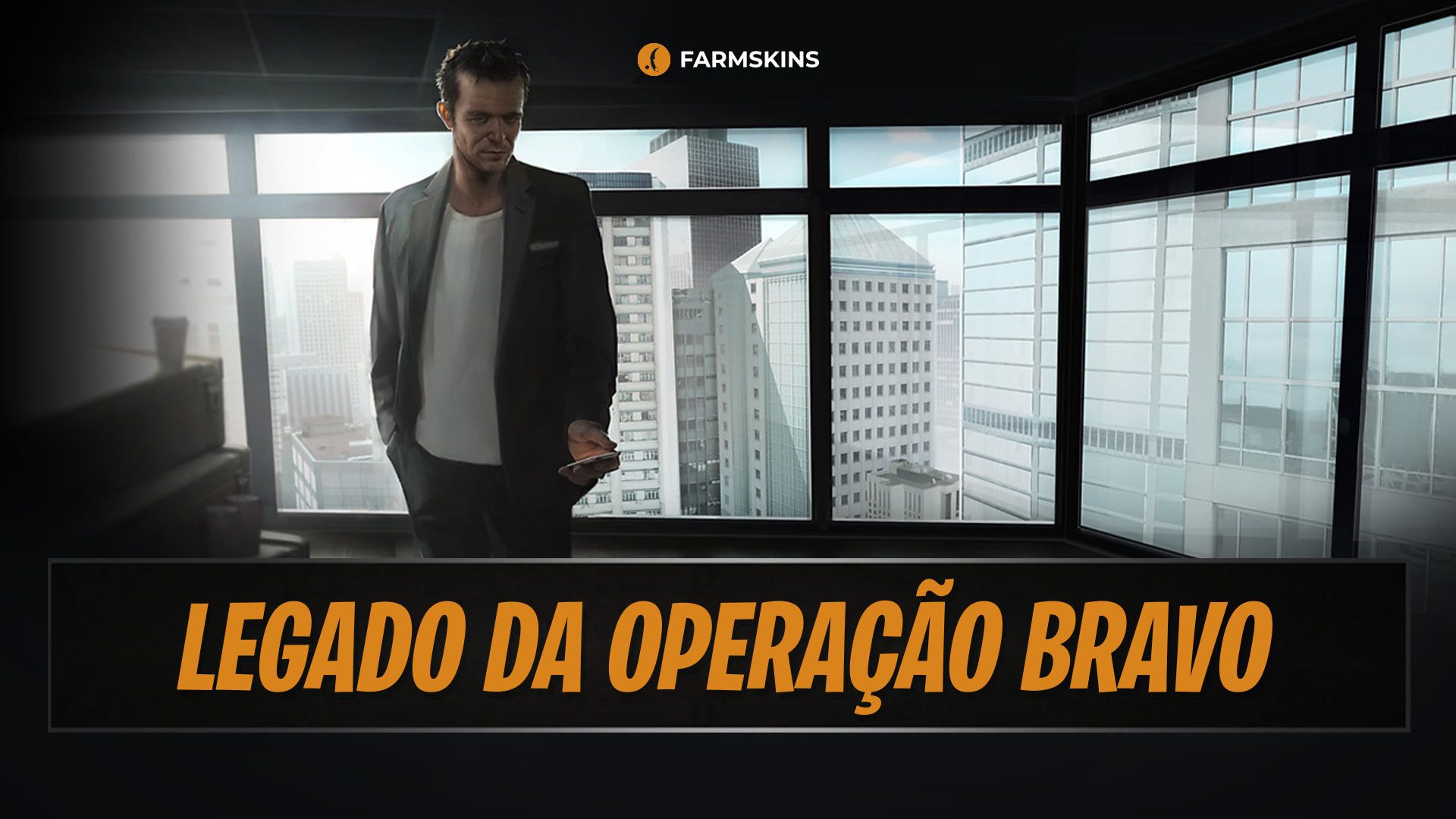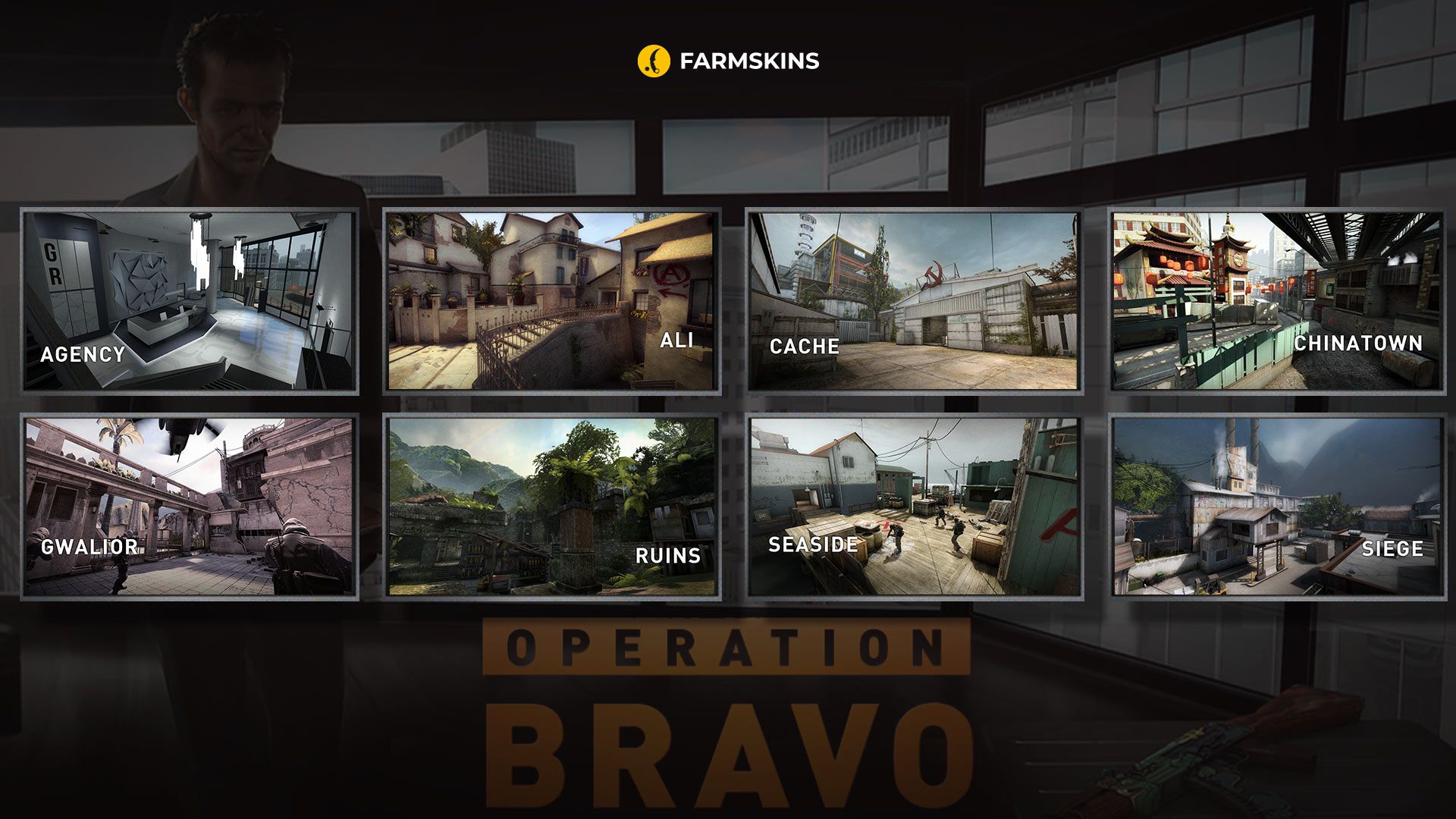Operation Bravo Legacy

Operation Bravo, launched on September 19, 2013, was the second-ever CS:GO operation, following the success of Operation Payback. It stood out as a significant moment in the game’s development, offering players not only new content but also the ability to support community map creators. For $5.99, players gained access to an array of community-created maps, alongside missions and challenges designed to test their skills across various game modes.
New Maps Introduced in Operation Bravo
One of the defining features of Operation Bravo was its introduction of eight community-created maps, giving players new battlegrounds that would leave a lasting impact on CS:GO. These maps were handpicked from the community and provided players with fresh, engaging environments for both casual and competitive play.

- Cache – Perhaps the most iconic of the bunch, Cache quickly became a fan favorite and went on to enter the competitive map pool. Its balanced layout, offering strategic depth, made it a staple for both professional matches and casual play.
-
Agency – A hostage rescue map set in a sleek, modern office building, Agency introduced a unique environment that stood out from the more traditional bomb-defusal maps. Its vertical gameplay and tight corners made it a thrilling experience for players seeking a change of pace.
-
Ali – A map set in an urban Middle Eastern environment, Ali offered intense close-quarters combat and a visually distinct atmosphere. While not as popular as some other Bravo maps, it still provided a fresh experience.
-
Seaside – As the name suggests, this map took players to a coastal town, providing a vibrant, open-air setting. Its mix of long sightlines and tight alleyways made it a map that rewarded both snipers and aggressive players alike.
-
Cobblestone – Another classic from Bravo, Cobblestone’s medieval castle aesthetic became instantly recognizable. Though later reworked, the original version of Cobblestone introduced with Bravo added variety to the map pool, giving players a unique theme to explore.
-
Gwalior – A visually striking map set in India, Gwalior brought a unique blend of architectural beauty and challenging gameplay. Its distinct style and tactical variety made it a fresh addition for players who enjoyed exploring new themes.
-
Overpass – Set in an urban environment with a blend of open spaces and tight corridors. The map’s complexity required teams to master multiple strategies, from controlling the central areas like the park and connector to executing coordinated pushes on bombsites.
-
Ruins – A bomb defusal map located in ancient ruins, Ruins was a mix of historical architecture and fast-paced action. The map’s design rewarded careful movement and strategic thinking, with plenty of spots for ambushes and outplays.

Community Involvement and the Evolution of Operations
One of the key aspects of Operation Bravo in CS:GO was its focus on highlighting talent from the community. Maps like Cache, which went on to become a staple in CS:GO’s competitive scene, were created by community members and gained widespread recognition through the operation. This level of visibility gave talented map designers the chance to have their work featured in official matchmaking, forever changing the trajectory of their careers.
With Operation Bravo, players could purchase access passes that contributed directly to the creators of the featured maps. Bravo is the only operation that introduced three competitive maps. Two of the main ones—Overpass and Cobblestone—were added to competitive matchmaking shortly after the operation ended. Overpass is still part of the competitive map pool, while Cobblestone was replaced by an updated version of Dust II in April 2018.
Both maps were created by the game developers. While Cobblestone had been played since the 1.6 era, Overpass was the first competitive map designed from scratch for CS:GO. The operation also featured Cache and Seaside; the former was added to the official map pool in July 2014, and the latter appeared in the “Scrimmage” mode in August 2019. Cache was the first competitive map created by the community. Like Overpass, Cache did not appear in previous games of the series. The revamped Cache was handled by the original developer, FMPONE.
Future operations like Operation Vanguard and Operation Wildfire built on the Bravo formula, incorporating more sophisticated campaigns, additional rewards, and refined mission structures. Bravo’s success demonstrated that community involvement was not just a gimmick but a vital part of CS:GO’s long-term growth.
The Impact of Bravo on CS:GO Economy and Skin Market
Operation Bravo had a lasting impact on CS:GO’s economy, particularly with the introduction of the Bravo Case, which contained highly coveted skins like the AK-47 | Fire Serpent and AWP | Graphite. These skins quickly became some of the most desirable items in the game. To this day, the Bravo Case remains one of the most valuable cases, with prices steadily rising as demand grows and supply decreases.
The operation also influenced the trading and investment side of the CS:GO market. Players began to view skins and cases as long-term investments. This trend solidified CS:GO’s in-game economy as a thriving marketplace where rare skins hold real-world value.
Bravo’s success demonstrated the profitability of limited-time content, setting a standard for future operations. It laid the groundwork for the skin market’s evolution, turning rare items into valuable commodities and shaping how players approach CS:GO trading and investments.
Operations Campaigns and Missions
Operation Bravo introduced a more refined progression system focused on missions and coin upgrades. As with previous operations, players received a coin for participating, but this time it was stored in their inventory and could be displayed on their CS:GO profile.
This Bravo coin was distinct from previous operations. Due to a recent competitive update, the criteria for upgrading the coin had changed. Instead of simply completing missions, players needed to invest 30 hours of gameplay on Operation maps and win 15 competitive games on those maps to upgrade the coin to its prestigious Gold tier. This made the progression feel more skill-based, as winning competitive games added an extra challenge for players aiming for the top-tier coin.
By completing missions in the two main campaigns—the Bravo Campaign and Operation Payback Campaign—players earned XP, loot, and progression toward upgrading their coin from Bronze to Silver and finally to Gold.
Legacy of Operation Bravo
Operation Bravo was a pivotal moment in CS:GO’s history, setting the standard for future operations. It introduced iconic community-created maps like Cache and influential skins such as the AK-47 | Fire Serpent, which helped shape the CS:GO skin economy. The operation’s coin and progression system, allowing players to upgrade and display their coin, became a core feature in later operations. Bravo also strengthened collaboration between Valve and the player community, making user-generated content a key part of the game’s evolution. Its impact on both gameplay and the in-game economy remains significant to this day.











